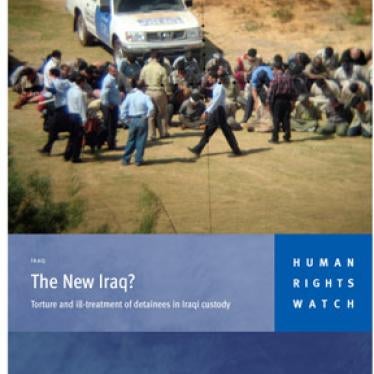By Michael Bochenek, Counsel to the Children's Rights Division of Human Rights Watch and author of "No Minor Matter: Children in Maryland's Jails."
Published in The Baltimore Sun
November 1, 2000
Maryland's commissioner of the Division of Pretrial Detention and Services, responded when asked recently about a federal investigation of conditions at the Baltimore City Detention Center, "We're not the Hyatt of jails, but we are the Motel 6." I've stayed at plenty of Motel 6s during the three years that I've conducted prison investigations for Human Rights Watch. And I've been to a lot of jails. As far as jails go, the Baltimore City Detention Center ranks among the worst I've seen.
I've stayed at plenty of Motel 6s during the three years that I've conducted prison investigations for Human Rights Watch. And I've been to a lot of jails.
As far as jails go, the Baltimore City Detention Center ranks among the worst I've seen. As for Motel 6s, there's really no comparison.
The U.S. Department of Justice opened an investigation of the city jail Oct. 16 amid concerns that the 200-year-old facility is subjecting detainees to a "life-threatening" environment. The Justice Department action followed a recommendation Human Rights Watch made in a November 1999 report that was based on an 11-month study of conditions at the jail.
We found that youths held in the Baltimore City Detention Center faced daily risks to their personal safety. Even though inmate violence has fallen in recent years, it remains unacceptably high, in large part because the jail's crumbling infrastructure gives detainees many opportunities to fashion handmade weapons known as "shanks."
Even more disturbing were the credible accounts we heard that some guards at the jail permitted fights between youths, a practice known as the "square dance."
Detainees told us that some guards would ask the youths if any of them had any scores to settle. If so, the other detainees would be locked in their cells and the fight would be held in an 8-square-foot area on one of the tiers of cells.
"It ends up with busted heads, slashes over your eyes, broken fingers, cut lips, maybe a broken nose," a former detainee told me in March. "But you don't go to the hospital for the cuts. If you did, there'd have to be a report, and the guards would have to explain why two guys were out in the square while everybody else was locked in."
In addition, jail officials routinely locked entire sections of the jail for extended periods, sometimes for a month or more. During lockdown, youths are permitted two or three showers a week and may attend classes, but they are otherwise restricted to their cells, denied contact with family members and prevented from attending religious services.
And when the warden decides that a particular detainee is a safety risk -- even if there had been no prior misbehavior --he may place the detainee in permanent administrative segregation, a status that Baltimore jail officials call "supermax."
This system means that a youth may be held 23 hours a day in oppressive cell confinement without a hearing and without committing any offense while in the jail. When we visited in May 1999, the jail did not have a system to review "supermax" placements. "You're right," Mr. Flanagan told me then. "They can write to the warden, but I won't sit here and tell you that there's an adjudicatory process."
Mental health services, another facet of the Justice Department's inquiry, were minimal to nonexistent in the city jail at the time of our investigation. Even though the jail added additional mental health staff after our report was released, in practice the only detainees who are able to access mental health services are those who are in crisis.
Patients in the mental health unit were housed in deplorable conditions. When we toured the cells designated for suicide watches, we found that they lacked important safety elements and contained numerous objects that a detainee could use to hang or injure himself. As we walked through these cells, the mental health expert who accompanied us looked over at me and commented, "This is about as unsafe as it could possibly be."
Jail officials attempt to justify these practices by noting that youths in the city jail have been charged as adults, often for violent crimes. But even if they are found guilty -- and many will be acquitted or have their charges dropped -- they have the right to be free from the kinds of serious abuses that prompted the Justice Department's investigation.
Mr. Flanagan should not trivialize conditions in the Baltimore City Detention Center by comparing the institution to a Motel 6. Motel 6s like to say, "We'll leave the light on for you." The jail might do that, but the comparisons end there.









